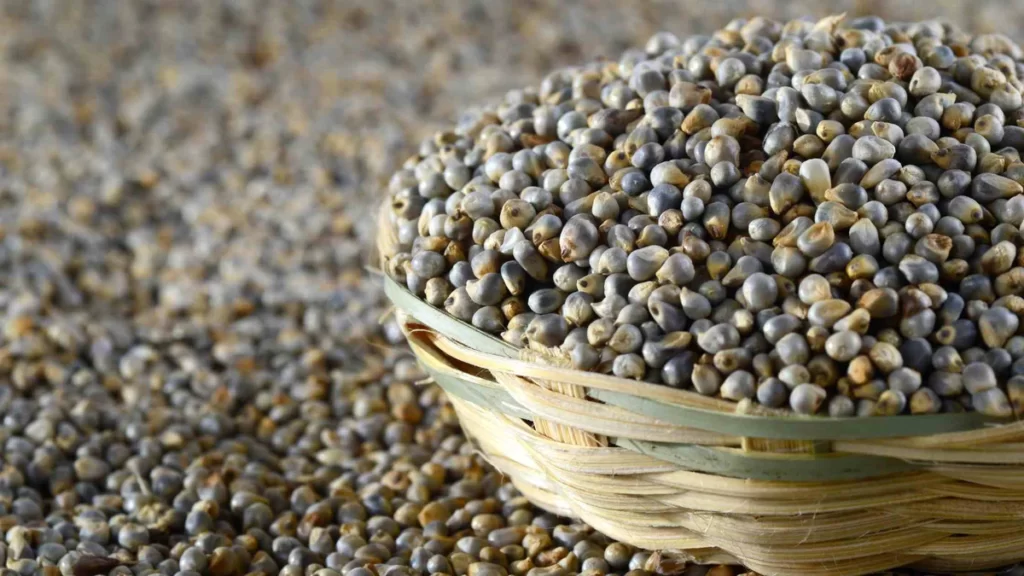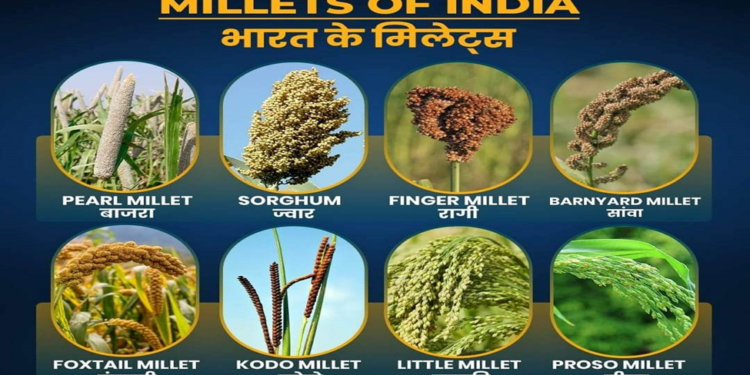- Author: GREAT MASTER VIKRANT ROHIN
- Date: MAY 3, 2023
Millets are a group a small, round whole grains grown in India, Nigeria, and other Asian and African countries. Considered an ancient grain, they are used both for human consumption and livestock and bird feed . They have multiple advantages over other crops, including drought and pest resistance
Millets are good sources of minerals, dietary fiber, antioxidants and protein with a low glycaemic index. millets, these grains possess numerous nutritional qualities and are good for consumption by all age groups of people including infants, elderly, pregnant, and nursing mothers. Other variants of millets are Sorghum (Jowar), Finger Millets (Ragi/Nachni), Proso Millets, Foxtail Millets, Little Millets (samai) that are used in various forms across the globe to enhance the nutritional value of regular meals.
Bajra is a traditional Hindi name for the Pennisetum glaucum crop — also known as pearl millet. It’s likewise known as dukn, cumbu, gero, sanio, kambu, babala, or bulrush millet
The grain is primarily grown in Africa and India, where it’s a major source of nutrition. However, it’s also grown and consumed in many other places around the world.
Bajra refers to the edible seeds of pearl millet plants. They grow in various shades of white, yellow, gray, brown, and bluish-purple.
The seeds are typically cooked as a cereal grain or sometimes finely ground and used as flour.
This article provides a general overview of bajra and its health benefits.

Bajra Nutrition
Bajra pearl millet is just one of many types of millet Some other popular varieties of millet are fonio, finger millet (ragi), Job’s tears, foxtail, and Kodo millet. Most millets have impressive nutritional profiles, including bajra
Here’s the average nutritional profile of 1 cup (170 grams) of cooked millet
- Calories: 201
- Protein: 6 grams
- Fat: 1.7 grams
- Carbs: 40 grams
- Fiber: 2 grams
- Sodium: 286 mg
- Folate: 8% of the Daily Value (DV)
- Iron: 6% of the DV
- Magnesium: 18% of the DV
- Thiamine: 15% of the DV
- Niacin: 14% of the DV
- Phosphorus: 14% of the DV
- Zinc: 14% of the DV
- Riboflavin: 11% of the DV
- Vitamin B6: 11% of the DV
Health Benefits Of Bajra
Bajra is high in beneficial plant chemicals like antioxidants, polyphenols, and phytochemicals, all of which are known for contributing to optimal human health in many ways However, the presence of beneficial polyphenols may also inhibit some of the minerals in bajra, such as iron and zinc, from being fully absorbed by your body
In general, cooked millet is a good source of protein and carbs and a decent source of fiber. It’s also a good source of vitamins and minerals. Overall, millet is a nutritious carbohydrate source.
Rich in antioxidants – Lessens free radical damage in the body and prevents early ageing, Alzheimer’s Disease, Parkinson’s Disease, cardiovascular diseases, and aids in wound healing.
- Good for High Blood Pressure Patients – Bajra is known for its richness in potassium which is needed for those with high blood pressure. Consuming more foods rich in potassium will help flush out sodium from your body, which in turn will reduce blood pressure.
- Lowers Blood Pressure– Bajra is known for its richness in potassium which is needed for those with high blood pressure. Consuming more foods rich in potassium will help flush out sodium from your body, which in turn will reduce blood pressure.
- Beneficial for Heart Health – Rich in dietary fibers and cholesterol-lowering properties of these grains are good for heart patients.
- Good for Diabetic Patients – Pearl millets contain carbohydrates that are digested slowly and maintain a stable glucose level for a long period. This makes them a healthy food option for diabetics.
- Good for Celiac disease and gluten intolerance: It’s also gluten-free and a suitable choice for people with celiac disease or those following a gluten-free diet — as long as you ensure that you’re purchasing a product that’s certified gluten-free
- Prevents Constipation– Benefits of bajra include promoting good gut health. In simpler terms, consuming the pearl millet will make sure you keep constipation at a distance. The reason behind this is the presence of insoluble fibre in bajra.
- Helps in relieving constipation – A good amount of dietary fibres aid in bulk formation and provide relief from constipation.
- Therapeutic for people with frequent acidity and stomach ulcers – Pearl millets are one of the few foods which reduce the acidity of the stomach thereby limiting ulcer formation and discomfort due to frequent bouts of acidity.
- Provides Protein To Vegetarians- Those who are vegetarians cannot get the needed protein from meat and fish products. This is where pearl millets come in. The health benefits of bajra include its ability to provide the required protein to vegetarians as well. Bajra flour becomes complete when it is combined with seeds like rajma, moong dal, chana dal, etc.
- Makes Bone Stronger – The high phosphorus content of bajra helps in making your bones stronger.
- Lowers Cholesterol- Pearl millets contain an adequate amount of good fat which is the desired quality of food for high cholesterol patients.
- Nutritious Baby Food – Pearl millets are easily digested and well tolerated by little ones which makes them a mandatory ingredient for baby food preparations during the weaning period and even later on.
- Ideal for Weight Management and Obesity.
- Reduces The Risk of Colon Cancers – It makes the stomach pH alkaline, and thus reduces the risk of colon cancers.
- A Healthy Choice of Food for Pregnant Women and Nursing Mothers Due to iron and folic acid contents.
SUMMARY: Like most millets, bajra is a nutrient-dense source of protein, carbs, vitamins, minerals, and beneficial plant chemicals.
Frequently Asked Question
Who should avoid bajra? Bajra may worsen digestive disorders: If you have irritable bowel syndrome, inflammatory bowel disease or Crohn’s disease then consuming even small amounts of bajra may cause your intestinal and stomach linings to get inflamed. If you have any such digestive disorder, you should avoid bajra क्या बाजरे की रोटी पचाना मुश्किल है?जटिल कार्बोहाइड्रेट से युक्त, बाजरे को पचने में लंबा समय लगता है, जिसके कारण इसमें उच्च ग्लाइसेमिक इंडेक्स होता है और यह लंबे समय तक पेट भरा हुआ महसूस कराता है। बाजरे में मौजूद फाइटोकेमिकल्स और पॉलीफेनोल्स प्रकृति में एंटी-कार्सिनोजेनिक और एंटीट्यूमर हैं
Is bajra bad for the thyroid? People having hypothyroidism should avoid millet consumption as they contain goitrogens that may interfere with iodine absorption.



